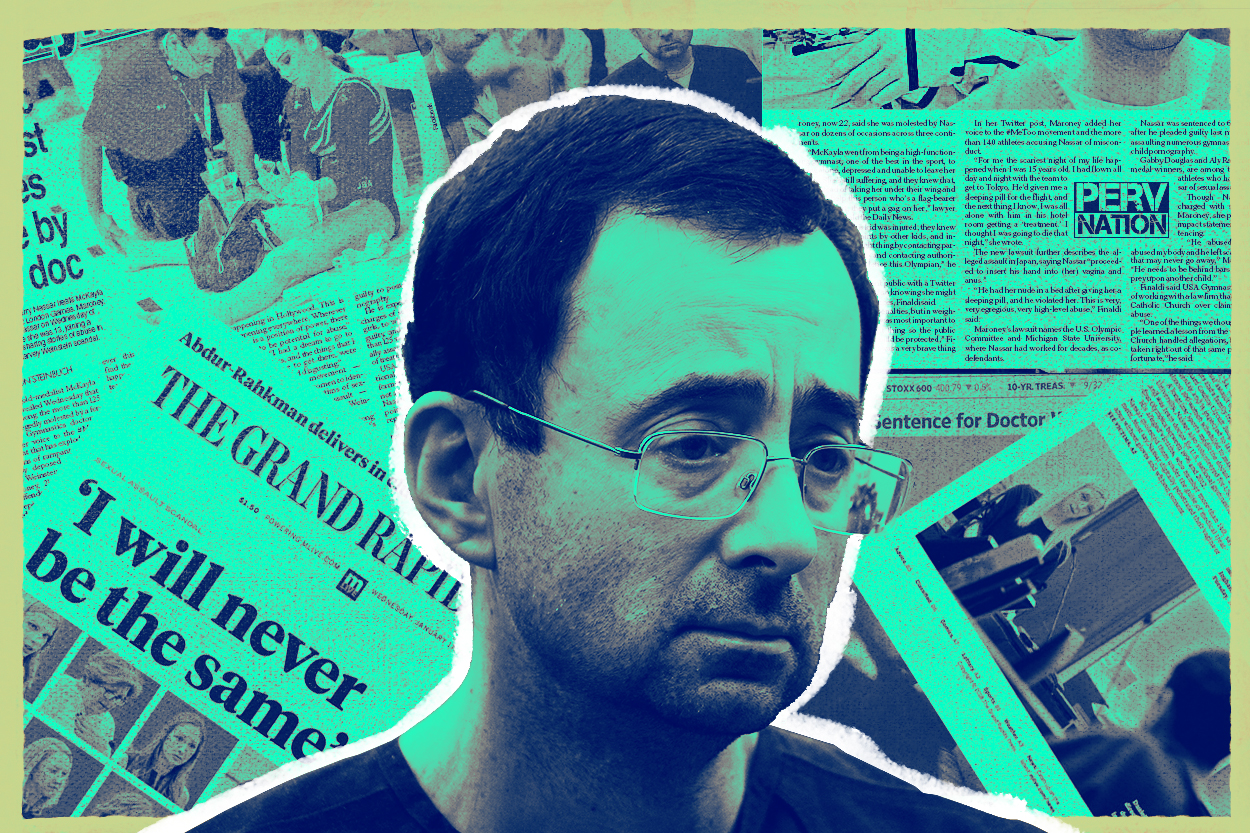“I just signed your death warrant.” That’s what Judge Rosemarie Aquilina said after sentencing Larry Nassar, the former Olympic gymnastics doctor, to 40 to 175 years in prison for sexually assaulting over 150 young female athletes, including Olympic medalists McKayla Maroney, Aly Raisman and Simone Biles.
Nassar, who also worked as a doctor for the Michigan State University athletic teams, molested girls as young as six years old and claimed he was performing “special treatment” on them. He used his authority to manipulate and coerce his victims into submission and silence. “Larry meticulously groomed me for the purpose of exploiting me for his own sexual gain,” Rachael Denhollander, the first women to publicly accuse the doctor, told Judge Aquilina.
This pattern of abuse can be traced all the way back to 1992 when Nassar was in medical school at Michigan State University. Nassar lured Denhollander, then a teenager, to his apartment because he needed her to participate in some “medical research he was doing and offered her a free full-body massage as compensation,” according to a federal lawsuit.
Flash-forward two years to 1994 when he started to assault Olympic medalist Jamie Dantzscher, which would last for six years. However, according to the lawsuit that Dantzscher filed back in 2016, the USA Gymnastic Organization knew about the abuse but “negligently suppressed, concealed or failed to disclose knowledge that Nassar had engaged in sexual conduct with team members.”
Because of the organization’s silence, over the next 20 years, many more parents would trust Nassar to treat their talented daughters for the many ailments they would receive doing the sport they loved so much. And the abuse didn’t just stop at the Olympic team; Nassar continued this abuse during his time at Michigan State University.
Michigan State University has also been accused of covering up the years of sexual abuse while Nassar worked there. “I reported it. Michigan State University, the school I loved and trusted, had the audacity to tell me that I did not understand the difference between sexual assault and a medical procedure,” Michigan State student Amanda Thomashow said in front of the court and Nassar earlier this week.
While the university president, Lou Anna Simon, resigned earlier this week after immense pressure from board members, that does little to make up for the years of neglected abuse. However, it did leave many faculty and students at the university talking about sexual assault on campus. “To the survivors of sexual abuse at MSU…we stand with you in saying that the time is now for us to collectively change and improve the overall culture and safety and security for everyone at Michigan State University,” Student Body President Lorenzo Santavicca said in a statement.
The NCAA also announced earlier this week that they will be conducting an investigation at the university due to their failure to address the reports of abuse by Nassar. The USA Gymnastics organization also announced the resignation of three top board members after the United States Olympic Committee demanded change from the top down. “Our position comes from a clear sense that USAG culture needs fundamental rebuilding,” said a letter written by the Olympic Committee.
In addition, all staff and board members in the organization will now be required to complete SafeSport training through the U.S. Center for SafeSport within the next three months and undergo ethics training in the next six months.
While all of these changes are swift and precise, will they actually change anything in the athletic community? These changes and resignations of top officials are signs that the athletic community is on the right track, but this sexual assault case goes so much deeper than the top officials.
The culture of silence that was built around Nassar for more than two decades runs deeper than many people acknowledge or are aware of, and that is where we need to start the repairs. While top officials resigning sends a harsh message and sets a precedent for how sexual abuse will be handled in the future, we must also look at the people closest to Nassar on the ground level.
This man was allowed access to young girls despite the warning signs and he didn’t get that access by acting alone. One man that comes up in this conversation is John Geddert, one of the top gymnastics coaches that worked alongside Nassar and one of his closest friends.
The gymnasts he coached described Geddert’s coaching style as harsh and intimidating, which was the opposite of Nassar who seemed quiet, calming and even safe. Their opposite demeanors, however, created an environment in which the girls felt unable to go to their own coach after being abused. “John and Larry were like this perfect storm,” Priscilla Kintigh, one of the gymnastics coached by Geddert, told ESPN. “You become so unapproachable that your own gymnasts don’t feel comfortable telling you what’s going on…kids were terrified of him.”
At Michigan State, at least 14 university representatives, including trainers, assistant coaches and even a detective, knew about Nassar sexually assaulting women on campus and did nothing in the 20 years he worked there. Eight women reported being assaulting by the doctor, but still nothing was done. Nassar wasn’t fired, suspended or even confronted after those allegations.
One of those women, Larissa Boyce, was just 16 years old when she was assaulted by Nassar in the 1990s after hurting her back during a youth gymnastics program at the university. When she told the then MSU head gymnastics coach, Kathie Klages, she was told it was just a misunderstanding. “She just couldn’t believe that was happening,” Boyce told The Detroit News. “She said I must be misunderstanding what was going on.”
Klages also went on to tell Boyce, “I can file this, but there are going to be serious consequences for you and Nassar.” Because Boyce didn’t want to get anyone in trouble, she remained silent all those years.
Now, maybe Klages honestly did not believe that Nassar was capable of sexually assaulting a teenage girl, but she should have at least taken her seriously and reported the assault to the police.
This “don’t ask, don’t tell” mentality is prevalent in all sexual abuse cases, as many saw with the Harvey Weinstein abuse scandal, and it is used to silence women and the people they confide in. Nassar was a respected man in the athletic community who was trusted by hundreds of parents to take care of their children and their children trusted him to be a nice doctor that would help them.
It would be nice to think that this is the last time we hear about Nassar or any sexual assault case, but that just simply isn’t true. Sexual assault will keep occurring if victims are silenced and abusers are free to roam, but the 150 women who spoke about their ordeal at Nassar’s sentencing prove that if women continue to speak out about these injustices, we can start building a new culture that won’t let victims be silent. They will hear them and, most importantly, help them put their abusers in prison.
“Let this sentence strike fear in anyone who thinks it is O.K. to hurt another person. Abusers, your time is up. The survivors are here, standing tall, and we are not going anywhere,” Aly Raisman said, standing before Judge Aquilina and Nassar.

















